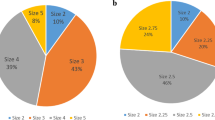Abstract
Introduction and hypothesis
To evaluate an association between hysterectomy and urinary incontinence (UI) in postmenopausal women.
Methods
Women (aged 50–79) with uteri (N = 53,569) and without uteri (N = 38,524) who enrolled in the Women’s Health Initiative (WHI) Observational Study between 1993 and 1996 were included in this secondary analysis. Baseline (BL) and 3-year demographic, health/physical forms and personal habit questionnaires were used. Statistical analyses included univariate and logistic regression methods.
Results
The baseline UI rate was 66.5 %, with 27.3 % of participants having stress urinary incontinence (SUI), 23 % having urge UI (UUI), and 12.4 % having mixed UI (MUI). 41.8 % of women had undergone hysterectomy, with 88.1 % having had the procedure before age 54. Controlling for health/physical variables, hysterectomy was associated with UI at BL (OR 1.25, 95 % CI 1.19, 1.32) and over the 3-year study period (OR 1.23, 95 % CI 1.11, 1.36). Excluding women with UI at BL, a higher incidence of UUI and SUI episodes was found in hysterectomy at year 3. Among women who had undergone hysterectomy, those with bilateral oophorectomy (BSO) did not have increased odds of developing UI at BL or over the 3-year study period. Hormone use was not associated with a change in UI incidence (estrogen + progesterone, p = 0.17; unopposed estrogen, p = 0.41).
Conclusions
Risk of UI is increased in postmenopausal women who had undergone hysterectomy compared with women with uteri.

Similar content being viewed by others
References
Carlson KJ, Nichols DH, Schiff I (1993) Indications for hysterectomy. N Engl J Med 328:856–860
Pokras R, Hufnagel VG (1987) Hysterectomies in the United States. Vital Health Stat 13:1–32
Hannestad YS, Rortveit G, Sandvik H, Hunskaar S (2000) A community-based epidemiological survey of female urinary incontinence: the Norwegian EPINCONT study. Epidemiology of Incontinence in the County of Nord-Trondelag. J Clin Epidemiol 53:1150–1157
Anger JT, Saigal CS, Litwin MS (2006) The prevalence of urinary incontinence among community dwelling adult women: results from the National Health and Nutrition Examination Survey. J Urol 175:601–604
Altman D, Lopez A, Falconer C, Zetterstrom J (2003) The impact of hysterectomy on lower urinary tract symptoms. Int Urogynecol J Pelvic Floor Dysfunct 14:418–423
Thakar R, Ayers S, Clarkson P et al (2002) Outcomes after total versus subtotal abdominal hysterectomy. N Engl J Med 347:1318–1325
Robert M, Soraisham A, Sauve R (2008) Postoperative urinary incontinence after total abdominal hysterectomy or supracervical hysterectomy: a metaanalysis. Am J Obstet Gynecol 198(264):e1–e5
Pakbaz M, Mogren I, Lofgren M (2009) Outcomes of vaginal hysterectomy for uterovaginal prolapse: a population-based, retrospective, cross-sectional study of patient perceptions of results including sexual activity, urinary symptoms, and provided care. BMC Womens Health 9:9
Brown JS, Sawaya G, Thom DH, Grady D (2000) Hysterectomy and urinary incontinence: a systematic review. Lancet 356:535–539
Van der Vaart CH, van der Bom JG, de Leeuw JR et al (2002) The contribution of hysterectomy to the occurrence of urge and stress urinary incontinence symptoms. BJOG 109:149–154
Virtanen H, Makinen J, Tenho T et al (1993) Effects of abdominal hysterectomy on urinary and sexual symptoms. Br J Urol 72:868–872
Clarke A, Black N, Rowe P et al (1995) Indications for and outcome of total abdominal hysterectomy for benign disease: a prospective cohort study. Br J Obstet Gynaecol 102:611–620
Griffith-Jones MD, Jarvis GJ, McNamara HM (1991) Adverse urinary symptoms after total abdominal hysterectomy–fact or fiction? Br J Urol 67:295–297
Howard BV, Kuller L, Langer R et al (2005) Risk of cardiovascular disease by hysterectomy status, with and without oophorectomy: the Women’s Health Initiative Observational Study. Circulation 111:1462–1470
Hendrix SL, Cochrane BB, Nygaard IE, Handa VL, Barnabei VM, Iglesia C et al (2005) Effects of estrogen with and without progestin on urinary incontinence. JAMA 293:935–948
Duru C, Jha S, Lashen H (2012) Urodynamic outcomes after hysterectomy for benign conditions: a systematic review and meta-analysis. Obstet Gynecol Surv 67:45–54
Gustafsson C, Ekstrom A, Brismar S, Altman D (2006) Urinary incontinence after hysterectomy–three-year observational study. Urology 68:769–774
Wu JM, Vaughan CP, Goode PS et al (2014) Prevalence and trends of symptomatic pelvic floor disorders in US women. Obstet Gynecol 123(1):141–148
Altman D, Granath F, Cnattingius S, Falconer C (2007) Hysterectomy and risk of stress-urinary-incontinence surgery: nationwide cohort study. Lancet 370:1494–1499
Gimbel H, Zobbe V, Andersen BJ et al (2005) Lower urinary tract symptoms after total and subtotal hysterectomy: results of a randomized controlled trial. Int Urogynecol J Pelvic Floor Dysfunct 16:257–262
Johnson N, Barlow D, Lethaby A et al (2005) Methods of hysterectomy: systematic review and meta-analysis of randomised controlled trials. BMJ 330:1478
Acknowledgements
We gratefully acknowledge the dedicated efforts of investigators and staff at the WHI clinical centers, the WHI clinical coordinating center, and the National Heart, Lung, and Blood Institute program office. Most importantly, we want to recognize the WHI participants for their extraordinary commitment to the WHI program.
Source of the study/funding/support
Study data were obtained from the observational study (OS) of the Women’s Health Initiative (WHI). The WHI program was funded by the National Heart, Lung, and Blood Institute of the National Institutes of Health, Department of Health and Human Services.
Conflicts of interest
None.
Author information
Authors and Affiliations
Corresponding author
Rights and permissions
About this article
Cite this article
Kudish, B.I., Shveiky, D., Gutman, R.E. et al. Hysterectomy and urinary incontinence in postmenopausal women. Int Urogynecol J 25, 1523–1531 (2014). https://doi.org/10.1007/s00192-014-2422-x
Received:
Accepted:
Published:
Issue Date:
DOI: https://doi.org/10.1007/s00192-014-2422-x




